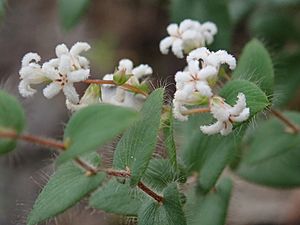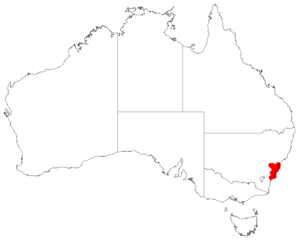Beard-heath facts for kids
Quick facts for kids Beard-heath |
|
|---|---|
 |
|
 |
|
| Scientific classification | |
| Genus: |
Leucopogon
|
| Species: |
amplexicaulis
|
 |
|
| Occurrence data from AVH | |
Leucopogon amplexicaulis, commonly known as the beard-heath, is a shrub found in southeastern Australia.
English botanist Edward Rudge was the first to describe this species as Styphelia amplexicaulis in 1807. It was later renamed by the prolific Scottish botanist, Robert Brown in his 1810 work Prodromus Florae Novae Hollandiae. The species name is Latin for "stem-clasping" and refers to the leaves.
It grows as a slender plant up to 0.9 m (3 ft) high, sometimes with a scrambling habit. The small branches have fine hairs. The leaves measure 9.5 to 34 mm in length by 4.5 to 20 mm across, and are distinctively heart-shaped and surround the stem at their base. The white flowers appear from July to November, peaking over August and September. Three to twelve small tubelike flowers arise along stalks up to 3.7 cm long. These are followed by the development of fleshy fruit known as drupes which are ripe from September to December.
Leucopogon amplexicaulis ranges from the Sydney Basin south to Shoalhaven on the New South Wales South Coast. It is found on sandstone soils in sclerophyll forest, where it grows in sheltered locations on sandstone outcrops and platforms, often near natural seepage. In the Sydney region it is associated with trees such as Sydney peppermint (Eucalyptus piperita), red bloodwood (Corymbia gummifera) and smooth-barked apple (Angophora costata), and shrubs such as heath banksia (Banksia ericifolia), coral fern (Gleichenia dicarpa) and dog rose (Bauera rubioides).
Plants live between twenty and thirty years, and become more common in areas long unburnt by bushfire. Leucopogon amplexicaulis is killed by fire and regenerates by seed. The seeds are thought to possibly be dispersed by ants.
Members of the genus Leucopogon are seldom cultivated, as their propagation by seed or cutting can be difficult. L. amplexicaulis requires a well-drained site with ample moisture and dappled shade in a garden situation.
Reproduction
Beard-heath is killed by fire and regenerates by seed. The seeds are thought to possibly be dispersed by ants. These plants, which are members of the genus Leucopogon are seldom cultivated as their propagation by seed or cutting can sometimes be difficult.
They can be cultivated if grown, in humus-enriched and well-drained soil. They best grown in full sun, which keeps the growth impact, and may benefit from light trimming. If they are propagated from seed, they mostly need stratification or prolonged soaking, of from layers or half-hardened tip cuttings. For growing in gardens, they must have a well-drained site with ample moisture and dappled shade with a cool root run provided by large stones.
Uses
It is mainly used for ornamental purposes in home gardens and public parks. They are also displayed at botanical gardens for educational purposes. It also has decorative value and can be used to make bouquets. It has various environmental beneficial effects which are similar to other plants. Its roots bind to the soil and prevent soil erosion.
The plant has chlorophyll in its leaves perform photosynthesis, which means taking in the carbon dioxide and releasing oxygen and thus fighting global warming.
Images for kids


